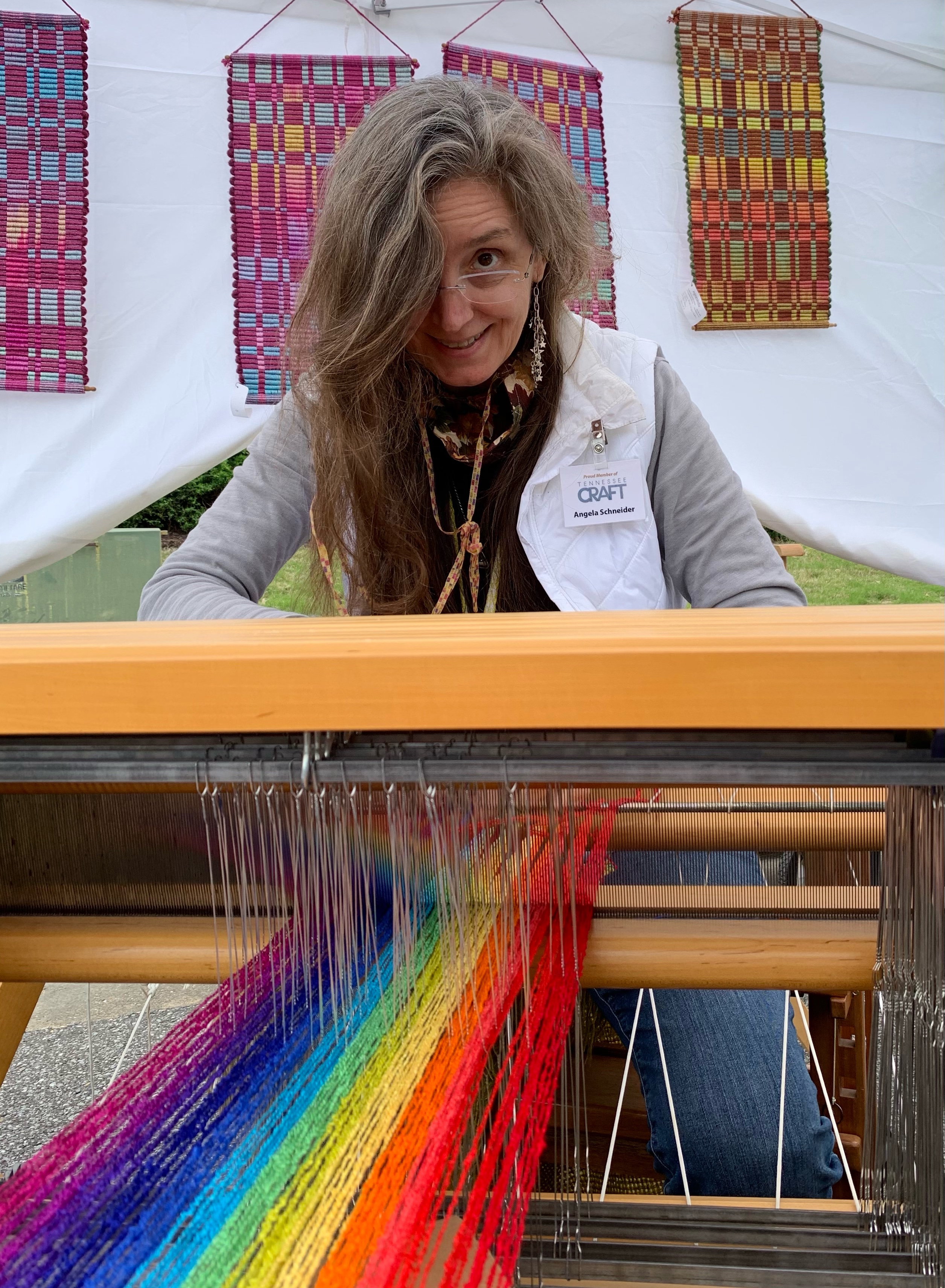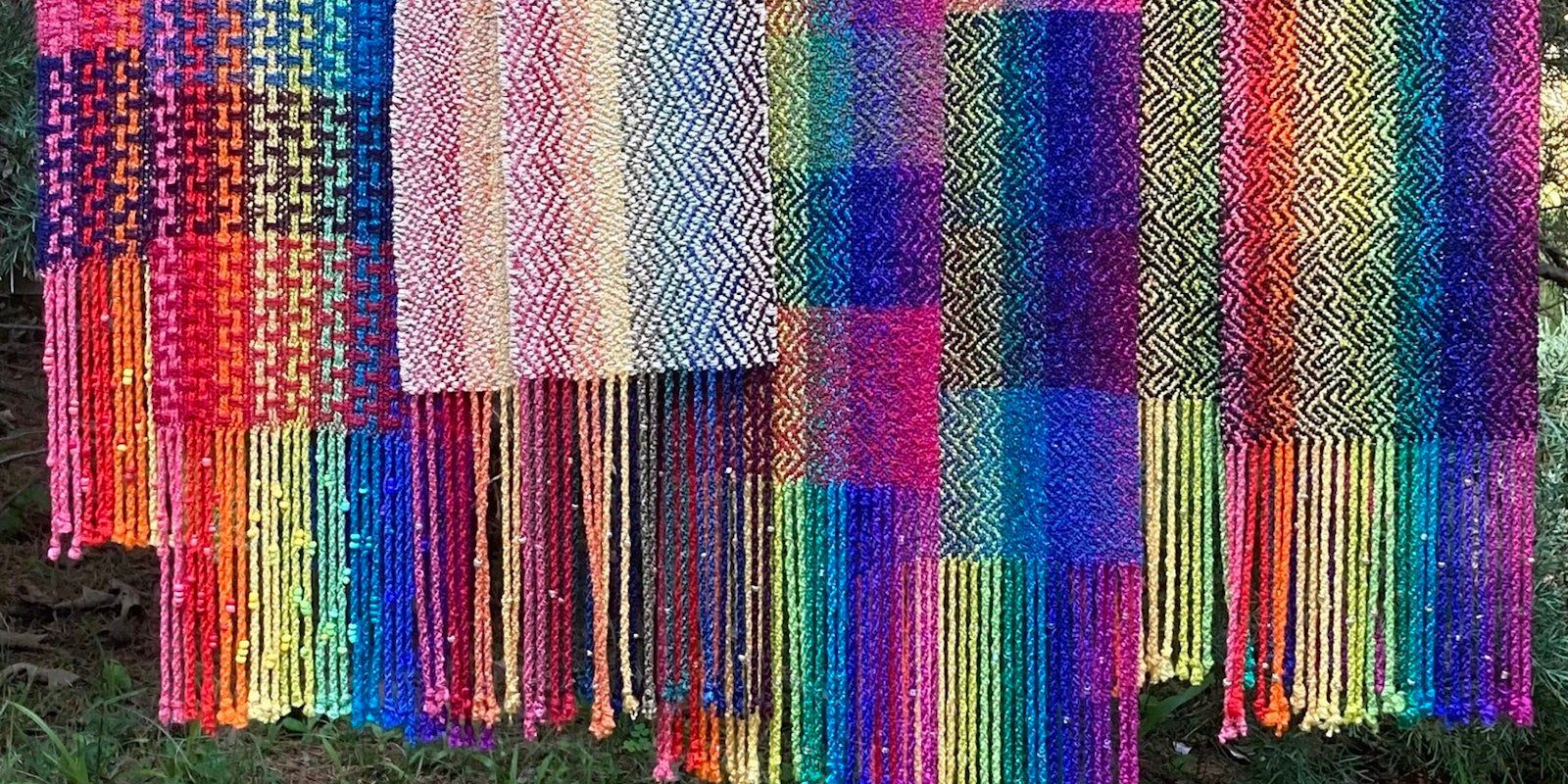Welcome to “Five Questions With,” where we get to know designers and their weaving a little better.
 For this edition we’re talking with Angela K. Schneider, Long Thread Media‘s project editor, where she is invaluable both for her weaving expertise and for her sharp eyes—neither errors in drafts nor stray threads on project photos escape her notice.
For this edition we’re talking with Angela K. Schneider, Long Thread Media‘s project editor, where she is invaluable both for her weaving expertise and for her sharp eyes—neither errors in drafts nor stray threads on project photos escape her notice.
Read on to learn more about what a project editor does, Angela‘s current loom count, good weaving music, and bulldogs vs. butterflies. —Lynn
L: You work as Long Thread Media’s project editor. What does a project editor do?
Long Thread Media publishes magazines about a broad range of handcraft topics, including weaving on big and little looms, knitting, spinning, embroidery, crochet, quilting, and tatting. I work with a group of technical editors to check all the numbers, drafts, and pattern steps for all the projects in the magazines, and ensure that our published instructions are complete and accurate. We don’t make every project ourselves, although I’m always curious, so when I‘m working on Handwoven or Little Looms projects I may throw something on a loom if it’s a new-to-me structure.
Coming up, I‘m very excited to be teaching at our upcoming Weave Together with Handwoven retreat in York, Pennsylvania on March 23–27, 2025. I have a two-day class that will focus on deflected doubleweave, as well as half-day classes introducing students to pin-loom weaving and to kumihimo braiding.
L: What do you have in your current herd of looms? Have you ever met a loom you didn’t like?
Looking around my studio, I probably have more than 40 if you count all the things that could be called a “loom,” including my vintage potholder loom from when I was a kid, pin looms, inkle looms, rigid heddle looms, tapestry looms, and a dozen or so multishaft table and floor looms—but so far none with more than 8 shafts. (And then there are all the braiding stands, knitting needles and crochet hooks, knitting machines, sewing machines, spinning wheels, dye pots, and so on.)
I once thought I wanted a dobby loom because of the design possibilities they provide, but I‘ve learned that I don’t enjoy the physical process of weaving on those. I like being engaged with the treadling and improvising with patterning as I weave, which is not easy to do on a dobby loom. A drawloom is on my wishlist, along with a shaft-switching set-up (and I'm willing to change my mind about the dobby). But realistically, there is always the issue of limited space...
There are a few specific looms I don’t enjoy weaving on, mainly because they’re a poor fit for my body.
Left: Angela‘s Sawtooth Stripe pillow design in deflected doubleweave, from the November/December 2021 issue of Handwoven. Right: Her textured Garden Party Purse for the rigid-heddle loom, from the Spring 2023 issue of Easy Weaving with Little Looms. Photos by Matt Graves
L: What drives you to weave? The desire to make a particular item, curiosity about a structure or process, or something else?
I’ve always felt compelled to make things, and weaving is an absolutely fascinating way to create. You can do simple structures and go crazy with color and texture, or you can go deep into complex structures.
I also enjoy the physical weaving process—the motions of my hands and feet. I think of it as a pleasant dance with yarn. Music often accompanies my weaving. I'm fond of throwing the shuttle to The Syncopaths‘ “The Very Last Straw” (from their album Five Gears).
Hands down, one of my favorite thing to make at the loom is new weavers. I love watching the lights go on in someone’s head as they suddenly understand the cloth.
I teach beginner classes in multishaft, inkle, tablet, and rigid-heddle weaving. For my “Weave a Scarf in a Day“ class, students can arrive in the morning with no knowledge, and walk out at the end of the day with a scarf they’ve woven from scratch. For more advanced students, I teach name drafting, double-faced tablet weaving, and the design possibilities of deflected doubleweave.
As a teacher, I’m always ready to meet students where they are. If you need step-by-step instructions when trying something new, I‘ll provide them. If you want to go off the rails and experiment, I‘ll offer guidance and freedom for those explorations. If you think you‘ve got it and want to dive deep into theory, I’m happy to geek out on weaving with you!
L: What inspires you when you design a draft? And after a project is woven, do you look back at the inspiration and consider whether you hit the mark? Or does working through the process change the goal?
I am all over the map with this. Sometimes I start with a particular design idea, and sometimes I let the materials lead the way. I like using math and language as a design source (for example, in name drafts).
I started off wanting to have everything planned out before I began weaving a project. That shifted as I took workshops (especially with Kathrin Weber), where I learned the value of surprising yourself. Now I believe that you don’t need to know exactly where you’re going when you begin. As I’m weaving, especially with new structures, I often notice something in the fabric that I didn’t on paper. The fabric itself leads me in a new direction.
I also like improvising at the loom, especially with deflected doubleweave. What are the pattern elements willing to do? I’m happy to take the next step and trust that something fabulous will happen along the way.
L: What’s on your list to weave or learn?
Some people are bulldogs, focusing on one subject, while others are butterflies, flitting from one idea to the next. I am definitely a butterfly. I want to try everything! That includes all the structures I haven’t woven yet, and some techniques that warrant more attention. Also: ikat, pile weaving, shibori, bobbin lace, garment construction...
While I do have a group of perennial structure favorites (deflected doubleweave, rep weave, pick-up, turned overshot, name drafts, and Baltic pickup on inkle looms), I’m most taken by whatever I just learned. The knitting needles and spinning wheel also call to me.
A few examples of Angela‘s collaborative work with other artists. From left: kuminimo braids in a copper sculpture by Lisa Ritenour; a backgammon board in modified 3-end block weave with shaft-switching, in collaboration with potter Rose Conway; and “Fill Your Sails” and “Steadfast,” in collaboration with sculptor Heidi Walter.
I also enjoy collaborating with others. My local artists’ guild has an annual show pairing people working in different disciplines. Through them, I’ve worked with potters, glass artists, sculptors, and woodworkers, and together we’ve come up with ideas neither would have had on our own.
Creativity takes courage, and I am grateful for the weavers and makers who put their creative energy out into the world. Whether you follow a pattern to the letter, change colors and make small adjustments, or design starting from scratch, it all counts as creative work and makes the world a little more beautiful.
Creative work also gets easier with practice, so keep weaving!
Happy weaving!
Lynn
Ed. note: If you want to learn from Angela in person, don‘t delay—a very few tickets are still available for our 2025 Weave Together with Handwoven retreat, but they‘re going fast!






